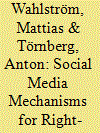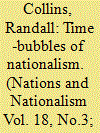| Srl | Item |
| 1 |
ID:
178941


|
|
|
|
|
| Summary/Abstract |
This article maps mechanisms by which online social media activities may contribute to right-wing political violence. High-impact studies on the wave of right-wing and racist violence in the 1990s and early 2000s established that mass media discourse on immigrants and previous violent incidents had a significant influence on the prevalence of radical right violence. This link was captured by Koopmans's and Olzak’s notion of discursive opportunities. However, this was before the dominance of online social networks and social media, which changed the media landscape radically. We argue for broadening and refining the operationalization of the concept of discursive opportunities in social movement studies as well as including in our theoretical models new mechanisms brought about by the new online media. In relation to radical right and anti-immigrant mobilizations in Sweden in the 2010s, we elaborate and exemplify three mechanisms through which activities on social media may affect the incidence of violence: a) having an increasingly co-produced discursive opportunity structure, b) making inter-group dynamics in movement groups and networks trans-local, and c) sharing (rare) practical information and co-ordinating activities.
|
|
|
|
|
|
|
|
|
|
|
|
|
|
|
|
| 2 |
ID:
114092


|
|
|
|
|
| Publication |
2012.
|
| Summary/Abstract |
The growth of modern nationalism can be attributed to structural causes, especially the growth of the strong bureaucratic state that penetrates society, creating cultural uniformity and national identity. But structurally based nationalism need not be very intense, or constant; even when institutionalised in periodic formal rituals, it can be routine, low in emotion - even boring. We need to explain sudden upsurges in popular nationalism, but also their persistence and fading in medium-length periods of time. Nationalist surges are connected with geopolitical rises and falls in the power-prestige of states: strong and expanding states absorb smaller particularistic identities into a prestigious whole; weaker and defeated states suffer delegitimation of the dominant nationality and fragment in sudden upsurges of localising nationalities. Passing from macro-patterns to micro-sociological mechanisms, conflict producing solidarity is a key mechanism: dramatic events focus widespread attention and assemble crowds into spontaneous 'natural rituals' - mass-participation interaction rituals, as distinct from formal rituals. Evidence from public assemblies and the display of national symbols following the terrorist attacks of 11 September 2001 (9/11) shows an intense period of three months, then gradual return to normal internal divisions by around six months. Spontaneous rituals of national solidarity are produced not only by external conflict but by internal uprisings, where an emotional upsurge of national identity is used to legitimate insurgent crowds and discredit regimes. Although participants experience momentary feelings of historic shifts, conflict-mobilised national solidarity lives in a 3-6-month time-bubble, and needs to institutionalise its successes rapidly to have long-term effects.
|
|
|
|
|
|
|
|
|
|
|
|
|
|
|
|